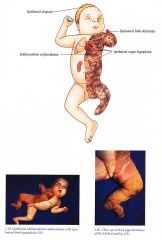![]()
![]()
![]()
Use LEFT and RIGHT arrow keys to navigate between flashcards;
Use UP and DOWN arrow keys to flip the card;
H to show hint;
A reads text to speech;
12 Cards in this Set
- Front
- Back
|
Clinical CHILD Syndrome
|

|
|
|
Synonym
|
Congenital hemidysplasia with ichthyosiform erythroderma and limb defects; Unilateral congenital ichthyosiform erythroderma
|
|
|
Inheritance
|
X linked dominant; NSDHL gene on Xq28
|
|
|
Prenatal
|
Ultrasound detection of limb/organ defects
|
|
|
Incidence
|
Rare; lethal in males
|
|
|
Age at Presentation
|
Birth to I month old
|
|
|
Pathogenesis
|
Mutations in the NSDHL gene encoding for 3P hydroxysteroid dehydrogenase are most common; EBP gene defect (i.e. Conradi's) has been described; both enzymes involved in cholesterol biosynthesis
|
|
|
Clinical
|
Skin
Unilateral ichthyosiform erythroderma with sharp midline cutoff involving trunk and limbs; ± linear or segmental involvement on contralateral side; lesions tend to improve with age but may persist in skin folds (ptychotropism) Hair lpsilateral alopecia Nails Severe dystrophy Musculoskeletal Hypoplasia to agenesis of limbs ipsilateral to ichthyosis; other ipsilateral bones may be involved; ± stippled epiphyses Internal Organs Hypoplasia to agenesis of organs below ichthyosis variety of organs reported in¬ cluding CNS, cardiovascular, renal, and genitourinary involvement |
|
|
D/Dx
|
Conradi Hunermann syndrome
inflammatory linear verrucous epidermal nevus |
|
|
Lab
|
Computed tomography/magnetic resonance imaging (CT/MRI) scan of ipsilateral side
|
|
|
Management
|
Referral to dermatologist topical therapy
Referral to orthopedist Referral to organ specific subspecialist |
|
|
Prognosis
|
Dependent on which organs are affected can range from normal life span to incompatible with life
|

